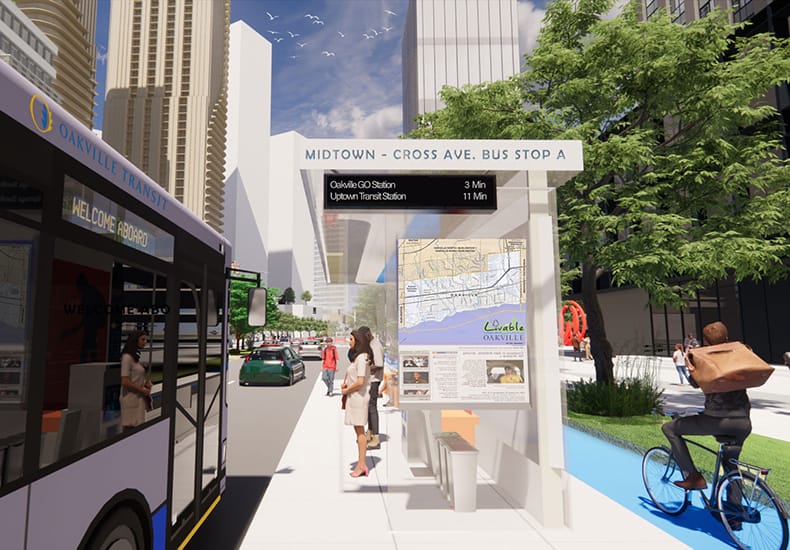Mayor: Every area in Oakville is ‘going to have its share’ of growth
Published May 15, 2023 at 9:36 am

Oakville is preparing itself for a whole lot of growing over the next decade.
While the Town has released its latest draft of its Official Plan Amendment (OPA) for Midtown Oakville and is currently inviting residents and businesses to provide their say, changes are coming all over town says Mayor Rob Burton.
Over 1.1 million people are expected to move into Halton Region, including Oakville, between 2031 and 2051.
The town is already growing among the fastest rates in the province. According to the 2021 Census, since 2016 the population of Oakville has increased by 10.3 per cent from 193,832 to 213,769.
The increase in Oakville is nearly twice both the provincial average (5.8 per cent) and the national average (5.2 per cent).
Oakville now ranks 11th among provincial populations and 25th among national populations.
“We have a whole heap of growing to do all over the province over the next 10 to 20 years and Oakville has to give permits for 33,000 housing units by 2031,” Burton told halton.insauga.com’s Khaled Iwamura during their monthly video chat.
“At the most at the start, Midtown will accommodate maybe 6,500, maybe 6,000 housing units. They’re the least of the 33,000 housing units that we have to bring in and they’re going to happen all over town, so every area is going to have its share.”
The province, according to its More Homes Built Faster Act (Bill 23), has requested some municipalities, including Oakville, answer to a Housing Pledge in an effort to tackle Ontario’s housing crisis.
The goal is to build 1.5 million new homes in the province by 2032.
While the town normally averages around 2,000 new units per year, Oakville council has pledged to accommodate the 33,000 new housing units by 2031/32.
The Midtown Oakville project is expected to accommodate about a third of those pledged housing units.
It will contain a mix of tall and mid-rise buildings, community services, and business opportunities close to the Oakville GO station.
The area covers approximately 103 hectares bounded by the QEW/Highway 403 to the north, Chartwell Road to the east, Cornwall Road to the south and the Sixteen Mile Creek valley to the west.
“Provincial legislation has designated 25 Urban Growth Centres across Ontario with minimum density targets for each one. Working together we can ensure that Midtown Oakville is Ontario’s most livable urban growth centre,” said Burton earlier this month.
“Our engaged community has an opportunity to help shape this exciting and historic project. Achieving success in Midtown is essential for our community’s future.”
The Province of Ontario currently requires Midtown Oakville be planned to accommodate a minimum of 20,600 people and jobs by 2031 (i.e. 200 people and jobs per hectare).
“Twenty thousand people and jobs is a minimum required by the province and we get to split that,” Burton told halton.insauga.com. “Our planning right now is for 13,000 residents and 7,000 jobs.”
The project is still a little ways from getting underway, though the Oakville mayor noted that the town has already received applications for the work to be done on the infrastructure.
“The first problem is to get the infrastructure in there,” Burton said when asked At the earliest we’ll get servicing, water and wastewater, by 2026 which is a good three years away.”
Additional infrastructure work that needs to be done is around modifying the QEW as it goes by Midtown. This will help people get in and out of the are reasonable well.
“If you have ever driven to Square One, if you’re a long time resident of the area, you will notice that they created a special long off-ramp called Centennial Drive that really facilitates the ability to get in and out of Square One. These are the kind of things that need to be done,” said Burton.
That, he says of the QEW work, is a provincial thing.
Also required is a bus bridge, a fly over the QEW for buses to come into Midtown and that Burton adds is a regional thing.
There is also a need to relocate a path of Cross Ave. and that is a town thing.
“So you got three levels of government that have to coordinate a whole bunch of expensive infrastructure and the result is that this is a very slow moving project,” said Burton.
“In fact, it’s more than its decreed and next to nothing has happened because of how hard it is to get and how long it takes to get the infrastructure in place.”
INhalton's Editorial Standards and Policies




